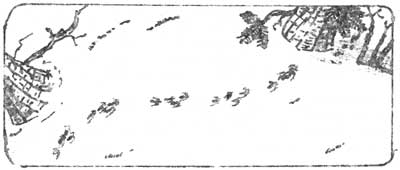PINE MARTEN (Martes americana)
Silent as smoke, a shadow slips from limb to limb through an ancient
and lofty doug fir. It lingers, practically melted from sight. Suddenly
it leaps forward and with flashing speed seizes a luckless squirrel.
All right, now you try it; climb a tree and grab a squirrel
with your bare hands. Amazing creature, the marten, eh? Preying on
squirrels in their natural habitat, though, is by no means all that
makes the pine marten a fascinating animal.
Like Kipling's Cat Who Walked by His Wild Alone, the marten prowls
his own solitary way, as do most mustelids. And like the feral cat he
catches birds--even grouse and quail--to vary his diet of small mammals
and occasional bugs, carrion, and berries.
In summer he likes to hang around talus slopes and rock slides, for
he's one of the few predators agile and swift enough to catch a pika. In
the main, though, he dislikes open areas--so much so that meadows
present a natural barrier to his movements. He's strictly a creature of
close forest who will travel a mile or more from tree to tree without
once touching ground. Rivers become barriers, too, for he hates to swim.
And therein lies the key to identifying a marten in the field.
Weasel, mink, marten, fisher and even otters look similar in outline.
On a grey day, when colors dissolve to bleakness and distance flattens
out too much to gauge accurately, visual ID alone may not suffice.
Habits tell the tale. Mink and otter love to swim and will take to water
if possible. They don't climb well. Marten and fisher don't like water;
trees are their turf. Weasels neither climb nor swim much but they'll
quickly and expertly disappear in the debris of the forest floor.
How to tell a marten from a fisher, it's equally predatory cousin? Up
in a tree, the marten looks a little like a huge squirrel flowing from
branch to branch. The fisher is too big to be mistaken for a squirrel
and its uniform coat, dull in any light, sulks dark and somber. The
marten's warm color, reddish or brown on top and yellow or even orange
on the breast, reminds you of a red fox. The feet and tail are darker,
the pointy face greyer to complete its fox look. Martens vary in color
from animal to animal, so much so that matching marten furs can give
furriers analgesic-size headaches.
That rich fur gives the marten its alternative name "sable," although
the true sable of furrier fame is a Eurasian relative. Indeed,
fur-trappers harried the marten nearly to extinction, and loggers didn't
help, for the marten prowls deep old-growth conifer forest almost
exclusively, hunting by its Wild Alone.
For a few brief weeks in mid-summer--its annual fling--the marten
puts aside its Wild Aloneness. Lady marten and gentleman frolic
together, kids again. Then, the idyll ended, they return to their
savage, solitary ways.
The fruit of their frolicking arrives the next spring after gestation
of either 27 days or 7 to 9 months, depending how you count. Because of
delayed implantation, the fertilized eggs (usually three or four) lie
dormant until February or so. Once implanted the eggs develop in less
than a month and the blind, naked young emerge weighing about an ounce.
Their eyes open at 39 days, Mama weans them at 6 or 7 weeks
and by the end of summer the kids are nearly grown--6 to 8 pounds, 16 or
17 inches long plus an 8 or 9 inch tail. They'll probably live 10 years
or so, unless they cross paths with a bobcat, fisher, eagle or one of the
big owls.
Because the marten sleeps deeply between periods of frenetic
activity, and both sleep and action come by day or by night, the rhythm
of light and dark mean little. The marten preys on nocturnal and diurnal
animals alike and in turn is stalked by predators of both day and night.
Seasons mean little, either; the marten may migrate vertically a little
way, but it never hibernates and seems to do equally well in balmy
summer and depths of winter.
Nor does the marten adopt a den to call 'home;' it sleeps wherever
handy, in a hollow log or tee, or perhaps a hole in a rotting stump. Its
only bow to comfort is to line a den with soft grass, moss and such for
its newborn babies.
Here in the park the marten has hobnobbed with some august company.
Back in 1897 C. Hart Merriam, with Vernon Bailey and A. K. Fisher, collected and
recorded it. Ben Longmire caught 35 of them in 1914 and Jack Schidell
reported trapping a dozen a couple years later. J. B. Flett and Claude
Tice wrote observations as have visitors and employees in the years
since.
So it's still here, this swift and vicious shadow. Though not common,
it haunts the flanks of our mountain in comparative safety, outrunning
squirrels high up in the wet tangles of fir and moss and dark, somber
silence.
Sandy Dengler


